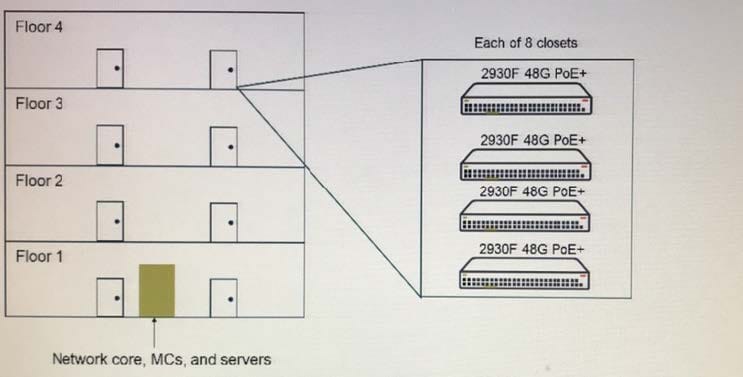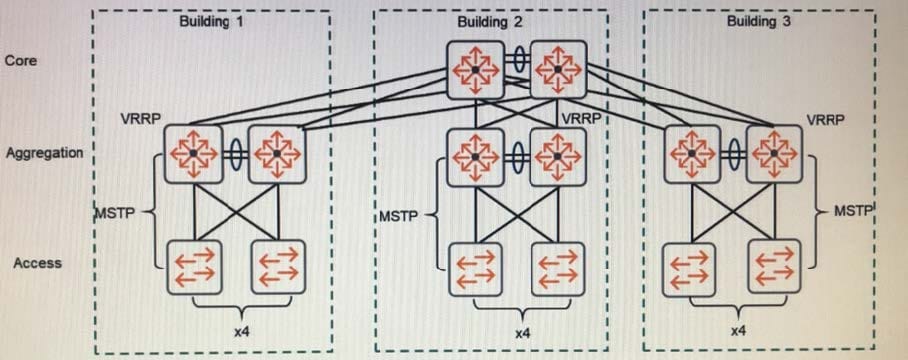Exam Details
Exam Code
:HPE6-A47Exam Name
:Designing Aruba SolutionsCertification
:HP CertificationsVendor
:HPTotal Questions
:68 Q&AsLast Updated
:Mar 23, 2025
HP HP Certifications HPE6-A47 Questions & Answers
-
Question 11:
Refer to the exhibit.

An architect needs to plan a network solution for a new office building with four floors. Each floor has two wiring closets with the equipment shown in the exhibit. The switches will connect to employee desktops, a few campus APs controlled by MCs, and printers. The switches do not implement tunneled node.
What is a best practice design for the VLANs and subnets for the wired devices?
A. one VLAN per closet and a /24 subnet for each VLAN
B. one VLAN per closet and a /25 subnet for each VLAN
C. one VLAN for the entire building and a /23 subnet
D. one VLAN per floor and a /24 subnet for each VLAN
-
Question 12:
For which scenario does the Aruba backplane stacking technology meet the needs?
A. The customer needs to deploy a pair of aggregation switches in the same closet, and wants to simplify the architecture and redundancy design.
B. The customer needs to simplify the deployment of core switches which are located in different closets for redundancy purposes.
C. The customer needs to expand the network and make it possible for the current core switches to support more MAC forwarding and ARP entries.
D. The customer needs to deploy a switch at a branch office and have the switch automatically discover and join the network stack at the main office.
-
Question 13:
What is one important guideline for antenna selection?
A. Ensure that the beam-width exceeds 100 degrees.
B. Ensure that the H-plane and E-plane values are within 45 degrees of each other.
C. Ensure that the antenna is rated for 802.11ac usage.
D. Ensure that the antenna is designed for the frequency used by the radio.
-
Question 14:
An architect plans where to deploy new Aruba 320 Series APs at a customer site. The architect plans for the APs to be installed on the ceiling where power is inaccessible. The Ethernet cable run to these locations is CAT6, and the customer wants to support at least 1 GbE connectivity. The architect plans to connect each AP with one Ethernet port to a switch in a nearby wiring closet.
Which feature does the switch need to support for this deployment?
A. PoE+
B. LACP
C. Port channel
D. Smart Rate
-
Question 15:
A customer needs a wired network solution that can recognize and prioritize a wide array of different types of traffic, including casual Web browsing, voice, video, SAP Online, and file sharing.
The architect needs to choose between the Aruba 2930F or the 2540 Switch Series for the access layer switch.
Why would the architect choose the 2930F rather than the 2540 Switch Series for this customer?
A. The 2930F Series supports LLDP-MED for detecting VoIP traffic, while the 2540 Series does not.
B. The 2930F Series supports advancing routing, including multi-area OSPF, while the 2540 Series does not.
C. The 2930F Series supports more options for class-based QoS policies that the 2540 Series.
D. The 2930F Series can provide better congestion management with its much deeper buffers.
-
Question 16:
An architect plans to purpose two Aruba Mobility Controllers (MCs) in a cluster. The customer has a large building that needs to support about 10,000 devices. The architect plans to associate the Employees WLAN with VLAN ID 10.
What is one Aruba best practice for this design?
A. Ensure that VLAN 10 is extended to the edge and Aruba APs are deployed on it.
B. Ensure that each user role on the MCs is associated with a different VLAN ID.
C. Ensure that the RADIUS server assigns users to different VLANs dynamically.
D. Ensure that optimization and suppression of unnecessary multicast is enabled.
-
Question 17:
What is one reason to recommend dedicated Air Monitors (AMs) for a customer, as opposed to APs that are doing WIPS in AP mode (hybrid)?
A. AMs can operate in a hybrid operation mode in which they can support clients, scan for threats, and contain detected threats.
B. AMs can implement wireless containment on any channel on which they detect a threat without negative impact on clients.
C. AMs can detect both 802.11 and non-802.11 sources of interference to the wireless network, while APs cannot.
D. AMs can maintain client and AP blacklists on their own without the need to communicate with a Mobility Controller (MC).
-
Question 18:
Refer to the exhibit.

A customer wants to replace the core and aggregation layer of an existing network. Currently the network routes between the aggregation layer and core, and uses the technologies shown in the exhibit.
The customer now wants to route at the core, instead of the aggregation layer, and extend some of the same VLANs in different buildings.
However, the customer cannot eliminate the aggregation layer at this point. What should the architect recommend?
A. Create a backplane stack at the aggregation layer and a VSF fabric at the core.
B. Implement broadcast filtering on switch-to-switch links across all of the buildings.
C. Combine all switches in the aggregation layer and core into a single backplane stack.
D. Use VRRP on the core and aggregation switches, with the aggregation switches acting as standby.
-
Question 19:
A customer requires a wireless upgrade. The architect proposes: Aruba AP-325s Mobility Controller (MC) 7210s Virtual Mobility Masters (MMs) ClearPass AirWave
The customer is interested in wired authentication, as well as wireless authentication, but does not have the budget to upgrade the wired network. The wired network does not currently support 802.1X or RADIUS.
Which feature of the Aruba solution should the architect explain to justify the proposed solution?
A. The customer can direct all wired traffic through the MCs, which will then apply security to that traffic.
B. The customer can direct all wired traffic through the MMs, which will impose basic security checks.
C. ClearPass OnConnect can enable wired authentication on these switches through the use of SNMP.
D. AirWave can manage these switches and shut down their ports if an unknown user or device connects.
-
Question 20:
What should an architect use as a guideline to determine when to define another VLAN for wireless devices?
A. the WLAN or SSID, with a different VLAN for each SSID
B. the AP deployment, with a different VLAN for each AP that is deployed
C. the number of devices, with a different VLAN for each 250 devices
D. the employee roles, with a different VLAN for each role or department
Related Exams:
HP0-D15
Administering HP CloudSystem Matrix SolutionsHP0-D20
Architecting the HP Matrix Operating EnvironmentHP2-E56
Selling HP SMB SolutionsHP2-H88
Selling HP Business Personal Systems Hardware 2019HP2-I14
Selling HP Supplies 2020HP2-I15
Selling HP Business Personal Systems Hardware 2020HP2-I17
Selling HP Printing Hardware 2020HP2-I44
Selling HP Workstations 2022HP2-I73
Selling HP Retail and Hospitality Solutions 2024HP2-N51
HP Application Lifecycle Management 12.x Software
Tips on How to Prepare for the Exams
Nowadays, the certification exams become more and more important and required by more and more enterprises when applying for a job. But how to prepare for the exam effectively? How to prepare for the exam in a short time with less efforts? How to get a ideal result and how to find the most reliable resources? Here on Vcedump.com, you will find all the answers. Vcedump.com provide not only HP exam questions, answers and explanations but also complete assistance on your exam preparation and certification application. If you are confused on your HPE6-A47 exam preparations and HP certification application, do not hesitate to visit our Vcedump.com to find your solutions here.